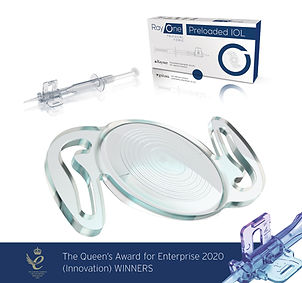
BM, PGCME, PGDipCRS (Dist.), CertLRS, FWCRS, FRCOphth
Consultant Ophthalmic Surgeon and Visiting Professor
A portion of all revenue is donated to
Stronger Together Across Ringwood and Fordingbridge (STARF)
a charity supporting local families suffering mental health or financial hardship






Artificial Lens Options
This section provides a broad overview of the different artificial lenses available for implantation during cataract and lens replacement surgery at South Coast Vision.
IMPORTANT: I have no financial interest in any products mentioned. While I have given talks for various companies about different lens implants, my choice of lens is purely based on scientific evidence, careful tracking of outcomes and my evaluation of each patient's specific needs.
Standard monofocal non-toric lenses
This is the type of lens used in standard cataract surgery, including on the NHS.
The specific model of standard monofocal non-toric lens that I use most frequently is the TECNIS PCB00, manufactured by Johnson & Johnson Vision. This lens is engineered to provide excellent optical clarity, long-term stability inside the eye and very few adverse visual side effects.
Read more about the TECNIS PCB00 lens here.
I have implanted over a thousand TECNIS lenses since 2011 and am very satisfied with its safety and visual outcomes. The fundamental TECNIS model is the basis of several newer, more specialised lenses that I sometimes use in RLE and refractive cataract surgery.
The drawbacks of monofocal non-toric lenses are that they cannot correct astigmatism and they only offer a single point of focus (with the usual target being distance). Monofocal non-toric lenses can be used to achieve increased spectacle freedom via monovision, whereby one eye is targeted for long distance and the other for intermediate to near vision.
Enhanced monofocal ("Monofocal Plus") lenses
While standard monofocal lenses offer excellent vision, they do so at a limited focal range, meaning glasses are needed for clear vision at other distances. A new type of lens, the so-called enhanced monofocal or monofocal plus lenses, aim to offer the same high quality of vision but with an increased range of focus (IROF). Most enhanced monofocal lenses achieve this by harnessing spherical aberration - a naturally occurring optical effect that increases depth of focus.
Enhanced monofocals can be used in different ways, for example:
-
Both eyes targeted for distance, giving excellent, balanced distance vision and often useful intermediate vision e.g. car dashboard, shelves in shops, dinner plate etc.
-
Modest monovision / blended vision: one eye is targeted for distance and the other is targeted for more near vision, giving good distance and intermediate vision, as well as often useful reading vision too. This is a similar concept to Presbyond laser vision correction, and delivers an excellent range of functional daily vision. Glasses are sometimes still needed for reading or more critical tasks such as driving at night.
The specific model of enhanced monofocal lens I use is the RayOne EMV lens from Rayner, which increases the eye's natural positive spherical aberration. Click below to watch a video of a lecture I gave in Vienna in 2022 about the RayOne EMV lens.

Monofocal toric lenses
Toric lenses have two meridians of focus at 90 degrees to each other, allowing them to compensate for regular astigmatism (rugby-ball shaped eye). They require accurate measurements of the eye before surgery, sophisticated calculations and careful marking and positioning to achieve the best results.
Astigmatism correction is complex and not an exact science, and occasionally re-rotation of the toric lens is required. The aim is to minimise astigmatism as far as possible, but it is rare (and unnecessary) to eliminate it completely.
Reducing astigmatism with toric lenses is one of my key interests. Read more here.
Multifocal (toric and non-toric) lenses
Multifocal lenses are designed to provide two or three different points of focus. Bifocal lenses were the first multifocal lens option available, providing distance and near vision. More recently, trifocal lenses have become available to provide:
-
distance vision (driving; most sports; watching television)
-
near vision (reading a book; using a smartphone)
-
intermediate vision (desktop computer; car dashboard)

The specific type of multifocal lens I use most frequently is the RayOne Trifocal lens, manufactured by Rayner. This lens is available in both a toric and non-toric version, meaning it can also correct astigmatism when necessary. As with all lenses in the RayOne family, it has an excellent track record of safety and outcomes. Although all trifocal lens implants are associated with glare and halo effects, I have found these to be far less of an issue with the Rayone Trifocal than with similar lens models from other manufacturers.
The Rayone Trifocal lens provides an excellent level of spectacle freedom, with over 9 in 10 people finding they can abandon glasses altogether. But as with all strategies for spectacle freedom, there is a compromise. The drawback with all multifocal lenses is that patients will be aware of some degree of halos and glare around lights, due to the concentric ring design of the lenses. This phenomenon is most noticeable for the first few days to weeks. It then gradually reduces, but will always be present to some extent, particularly at night. The vast majority of patients find they learn to ignore this and simply enjoy the benefits that multifocality brings. However, a small proportion of patients (less than 1 in 100) find the halos and / or glare difficult to tolerate and may choose to have the lenses removed.
Other lenses
A wide variety of excellent artificial lenses are available. I am continually evaluating new technology and offer new options once I am convinced that they offer genuine advantages. I have access to all lenses that are CE approved and on the market for use in Europe, so if you are interested in a particular lens, please let me know and we can work together to establish whether it would be the right choice for you.


